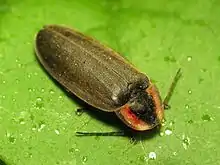| Ellychnia corrusca | |
|---|---|
 | |
| Scientific classification | |
| Kingdom: | |
| Phylum: | |
| Class: | |
| Order: | |
| Suborder: | |
| Family: | |
| Subfamily: | |
| Genus: | |
| Species: | E. corrusca |
| Binomial name | |
| Ellychnia corrusca Linnaeus, 1767 | |
Ellychnia corrusca, or winter firefly,[2] is a species of firefly in the genus Ellychnia.[3] It is a lantern-less diurnal beetle common in the United States, Mexico, and Canada. The adults spend winter on a colony tree, favoring Quercus (oak), Carya (hickory), and Liriodendron tulipifera (tulip poplar).[2]
Description
Ellychnia corrusca is a medium to large beetle, with adults that are 9 to 18 mm (0.4 to 0.7 in) long. The head shield, or pronotum, has a black, rounded central mark bordered by yellow and pink on both sides. The pronotum has black edges. The wing covers, or elytra, are dark and have fine hairs that can seem greenish or golden in certain light conditions. Adult E. corrusca do not have lanterns.[2] The last abdominal segment on the underside of the adults differs between males and females. On males, it is small and rounded, and on females it is larger and triangular with a small central notch.[4]
The larvae are dark with pink sides and thick, bristled bodies. They grow up to 17 mm (0.67 in) long. Each larva has two lanterns that glow.[2]
Life Cycle
Adults
In northern areas (around the 40th parallel north and above), adults emerge in the fall and overwinter on the bark of certain colony trees, becoming active as temperatures warm in early spring.[4] The mating season is approximately six weeks in length, occurring early April through mid-May.[5] In southern areas, adults emerge in late winter, February and March, and begin crawling up tree trunks, mating in early spring.[4]
The mating process consists of the E. corrusca adults crawling around tree trunks looking for mates in the early spring. Males first contact females with their antennae before they mount females dorsally to initiate copulation.[6]

Eggs, Larvae, and Pupae
After mating, the females lay their eggs nearby, and they hatch in early summer. In the north, the larvae eat and grow within decaying wood for the next 16 months, pupating in the late summer of their second year. In the south, E. corrusca completes its life cycle in one year, with the larvae pupating after a single summer and fall, becoming adults in late winter.[4]
Habitat
E. corrusca can be found in a variety of habitats, most commonly in maturing hardwood forests, yards, and open parks with large trees.[2]
Range
E. corrusca is common throughout the United States, Mexico, and Canada east of the Rocky Mountains.[1]
Light Production
Adults have no lanterns and are diurnal, unlike most flashing fireflies. Larvae are bioluminescent.[2]
References
- 1 2 Fallon, C. (2021). "Ellychnia corrusca". IUCN Red List of Threatened Species. 2021: e.T164013862A166771263. doi:10.2305/IUCN.UK.2021-1.RLTS.T164013862A166771263.en. Retrieved 28 August 2023.
- 1 2 3 4 5 6 Lynn Frierson Faust (1 March 2017). Fireflies, Glow-worms, and Lightning Bugs: Identification and Natural History of the Fireflies of the Eastern and Central United States and Canada. University of Georgia Press. pp. 73–77. ISBN 978-0-8203-4872-8.
- ↑ "Ellychnia". Integrated Taxonomic Information System. Retrieved 14 February 2017.
- 1 2 3 4 Lewis, Sara (2016). Silent Sparks, the Wondrous World of Fireflies. Princeton University Press. ISBN 978-0-691-16268-3.
- ↑ Rooney, Jennifer A.; Lewis, Sara M. (2000-09-01). "Notes on the Life History and Mating Behavior of Ellychnia Corrusca (Coloeptera: Lampyridae)". Florida Entomologist: 324. doi:10.2307/3496351. ISSN 1938-5102. JSTOR 3496351.
- ↑ Ming, & Lewis, S. M. (2010). Mate Recognition and Sex Differences in Cuticular Hydrocarbons of the Diurnal Firefly Ellychnia corrusca (Coleoptera: Lampyridae). Annals of the Entomological Society of America., 103(1), 128–133. https://doi.org/10.1603/008.103.0116
